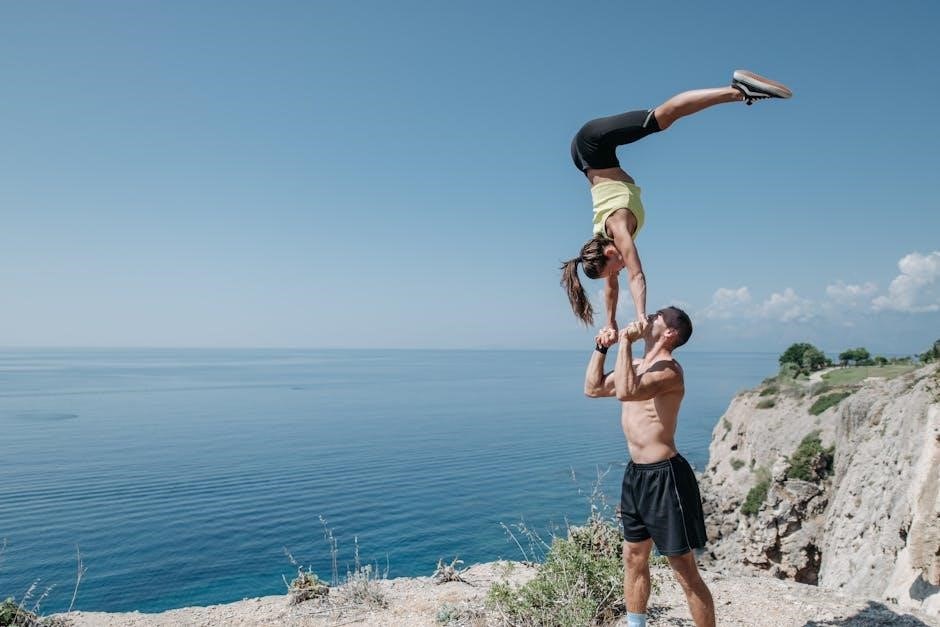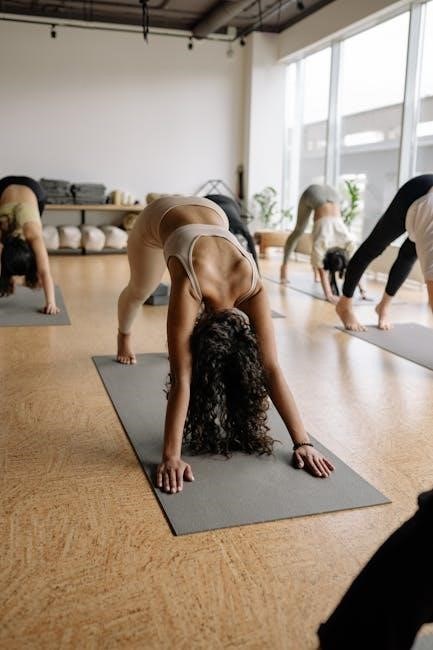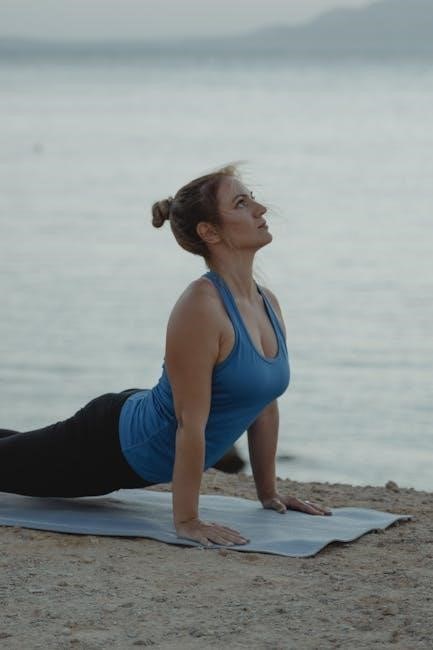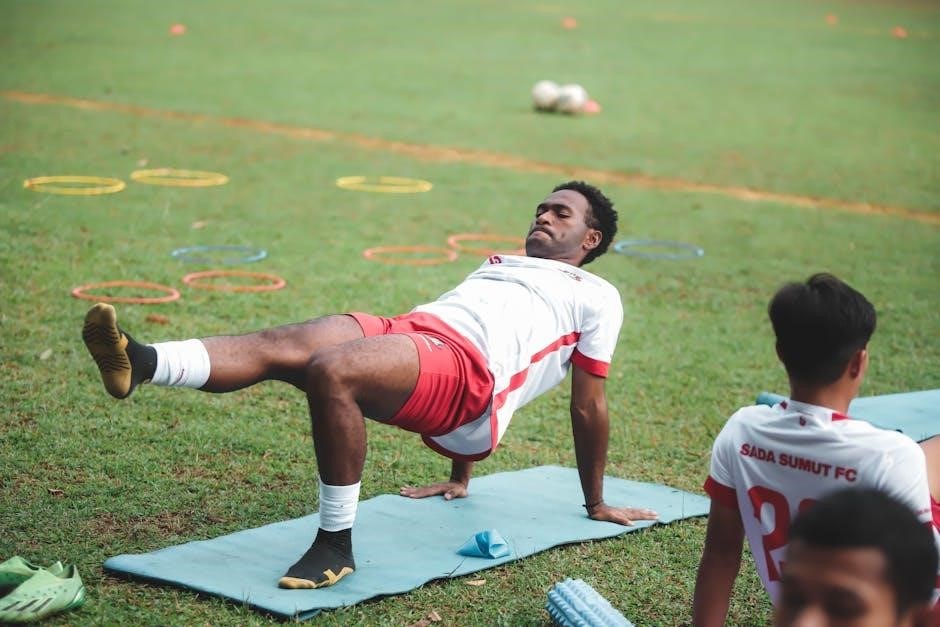Calf stretching exercises are essential for improving flexibility and relieving muscle tension. Regular stretching enhances blood flow and reduces the risk of injury or pain.
1.1 Importance of Calf Stretches for Mobility and Pain Relief
Calf stretches are crucial for maintaining mobility and alleviating pain. Tight calf muscles can limit movement and lead to discomfort, especially in the heels and lower legs. Regular stretching improves circulation, reduces muscle tension, and enhances flexibility. It also helps prevent injuries and provides relief from conditions like plantar fasciitis. Incorporating calf stretches into your routine can significantly improve overall lower limb function and reduce pain, making daily activities more comfortable and enjoyable.
1.2 Brief Overview of Calf Anatomy and Function
The calf consists of two primary muscles: the gastrocnemius and soleus. These muscles work together to facilitate movements like walking, running, and balance. The gastrocnemius is the outer, larger muscle, while the soleus is deeper and plays a key role in posture; Both muscles connect to the Achilles tendon, which attaches to the heel bone. Proper functioning of the calf muscles is essential for mobility, stability, and preventing conditions like plantar fasciitis. Tightness in these muscles can lead to discomfort and limited movement.
Benefits of Regular Calf Stretching
Regular calf stretching enhances flexibility, prevents injuries, and alleviates conditions like plantar fasciitis. It improves range of motion, reduces muscle tightness, and promotes overall lower limb health.
2.1 Improved Flexibility and Range of Motion
Regular calf stretching enhances flexibility by lengthening the gastrocnemius and soleus muscles, improving joint mobility. This allows for better movement in daily activities and sports. Standing calf stretches and seated towel stretches target these muscles effectively, promoting relaxation and reducing stiffness. Over time, consistent stretching increases the range of motion, making it easier to perform tasks like walking, running, or climbing stairs. Improved flexibility also supports athletic performance and reduces the risk of muscle imbalances.
2.2 Prevention of Injuries and Muscle Strains
Regular calf stretching significantly reduces the risk of injuries and muscle strains by maintaining muscle flexibility and strength. Tight calf muscles can lead to strains during physical activity, particularly in sports involving running or jumping. Stretching the gastrocnemius and soleus muscles helps prevent tears and pulls. Incorporating exercises like standing calf stretches and towel stretches into a daily routine can promote muscle resilience, ensuring safer participation in exercise and reducing the likelihood of discomfort or harm during movement.
2.3 Relief from Plantar Fasciitis and Heel Pain
Calf stretching exercises are highly effective in alleviating plantar fasciitis and heel pain by reducing tension in the plantar fascia. Tight calf muscles often contribute to discomfort in the heel and bottom of the foot. Regular stretches, such as the seated towel stretch or heel-cord board stretch, can improve flexibility and reduce pain. Consistent practice of these exercises helps relieve inflammation and promotes long-term comfort for individuals suffering from plantar fasciitis or chronic heel pain.
Types of Calf Stretching Exercises
Calf stretching exercises include various techniques such as standing stretches, seated towel stretches, and wall push-ups, each targeting different calf muscles for optimal flexibility and relief.
3.1 Standing Calf Stretch
The standing calf stretch is a simple yet effective exercise. Stand facing a wall with one hand on it for balance. Step one foot back, keeping the heel on the ground and the knee straight. Bend the front knee slightly, leaning forward until a stretch is felt in the calf. Hold for 30 seconds, then switch legs. This stretch improves flexibility and relieves tightness, making it ideal for daily routines or post-workout recovery.
3.2 Seated Calf Stretch with Towel
Sit on the floor with legs extended straight. Loop a towel around the ball of one foot, holding both ends. Gently pull the towel back, keeping the knee straight, until a stretch is felt in the calf. Hold for 30 seconds, then switch legs. This exercise is ideal for improving flexibility and relieving tightness, especially for those who prefer seated stretches. It targets both the gastrocnemius and soleus muscles effectively, enhancing overall lower leg mobility and comfort.
3.3 Wall Push-Up Calf Stretch
Stand facing a wall, hands placed shoulder-height for support. Step one foot back about a foot, keeping the heel on the ground. Slowly bend the front knee, pressing the back heel toward the floor until a stretch is felt in the calf. Hold for 30 seconds, then switch legs. This stretch effectively targets the calf muscles, improving flexibility and reducing muscle tightness. It’s a convenient exercise that can be done anywhere with a wall, making it ideal for daily routines.

Step-by-Step Instructions for Calf Stretches
Position your body for the chosen stretch, bend your knees slightly, and hold the stretch for 30 seconds. Repeat for the other leg to ensure balanced flexibility and muscle relief.
4.1 Heel-Cord Board Stretch
Place the ball of your foot on a slanted board, pressing your heel toward the floor. Hold for 30 seconds, then switch legs. This stretch targets the heel cord and calf muscles, improving flexibility and relieving tightness. Repeat daily for optimal results. It’s essential to maintain a gentle stretch without causing pain. This exercise is particularly effective for addressing plantar fasciitis and enhancing overall lower leg mobility. Consistency is key for long-term benefits.
4.2 Static Stretching Techniques
Static stretching involves holding a stretch for a duration to lengthen muscles. For calf stretches, hold each position for 20-30 seconds and repeat 2-3 times. This method enhances flexibility and reduces muscle stiffness. Focus on gentle, sustained pressure without bouncing to avoid injury.
A common technique is the standing calf stretch: face a wall, step one leg back, and press the heel down. Keep the knee straight and hold. Switch legs and repeat. This promotes relaxation and improves range of motion, making it ideal for daily routines or post-exercise recovery.

Frequency and Duration of Calf Stretching
Perform calf stretches 2-3 times daily, holding each stretch for 20-30 seconds. Consistency for 3-4 months yields optimal results for flexibility and pain relief.
5.1 Recommended Daily Routine
Aim to perform calf stretches 2-3 times daily, with each session lasting 5-10 minutes. Start with gentle stretches, such as the standing calf stretch or seated towel stretch, to improve flexibility without causing discomfort. Incorporate these exercises into your morning and evening routines, as well as before and after workouts. Consistency is key, so maintain this practice for at least 3-4 months to achieve noticeable improvements in muscle elasticity and pain reduction. Begin slowly and increase intensity as comfort allows.
5.2 Duration of Each Stretch
Hold each calf stretch for 20-30 seconds to maximize muscle relaxation and flexibility. Repeat 2-3 times per session for optimal results. Start with shorter durations if new to stretching and gradually increase as comfort improves. For static stretches like the standing calf stretch or seated towel stretch, maintain steady pressure without bouncing. Adjust time based on individual tolerance and goals, ensuring a gentle, sustained stretch to avoid discomfort or injury. Consistency is key for long-term benefits.

Precautions and Safety Tips
Avoid overstretching to prevent muscle strain. Stop if pain occurs. Consult a doctor before stretching after surgery. Use proper form to ensure safety and effectiveness.
6.1 Avoiding Overstretching and Pain
To avoid overstretching, focus on gentle, controlled movements. Stop immediately if sharp pain occurs. Avoid bouncing or forcing the stretch beyond a comfortable range. Ensure proper warm-up before stretching to reduce muscle tension. Use assistive devices like towels or boards if needed. If pain persists, consult a healthcare professional. Prioritize mild discomfort over intense pain to prevent injury and promote safe, effective stretching practices.
6.2 Modifications for Beginners
Beginners can modify calf stretches to suit their flexibility level. Use a towel or resistance band to assist with deeper stretches. Start with shorter holds and gradually increase duration. Perform stretches while seated or against a wall for stability. Focus on gentle, controlled movements to avoid strain. If balance is an issue, use a chair or wall for support. Prioritize comfort and progress slowly to build flexibility and confidence over time.

Incorporating Calf Stretches into Your Workout Routine
Incorporate calf stretches into your workout by performing them during warm-ups and cool-downs. This enhances flexibility, prevents injuries, and improves overall muscle function and performance.
7.1 Pre-Exercise Warm-Up
A pre-exercise warm-up with calf stretches improves flexibility and circulation, preparing muscles for activity. Start with gentle static stretches or towel stretches, holding each for 30 seconds. Avoid bouncing to prevent muscle strain. Focus on both gastrocnemius and soleus muscles for comprehensive warm-up benefits. Incorporate wall push-ups or standing calf stretches to enhance range of motion. Regular pre-exercise calf stretching reduces injury risk and ensures optimal performance during workouts or physical activities.
7.2 Post-Exercise Cool-Down
A post-exercise cool-down with calf stretches helps relieve muscle tension and prevent soreness. Gentle static stretches or towel stretches can be performed, holding each for 30 seconds. Focus on both the gastrocnemius and soleus muscles to promote recovery. Standing calf stretches or seated towel stretches are ideal for this phase. Regular post-exercise calf stretching enhances flexibility, reduces muscle stiffness, and supports overall recovery. Aim to perform 2-3 sets of each stretch to maximize benefits and ensure proper muscle relaxation after physical activity.

Additional Resources for Calf Stretching
8.1 Printable PDF Guides
8.2 Video Demonstrations
Video demonstrations provide visual guidance for performing calf stretches safely and effectively. They often include step-by-step instructions for exercises like standing calf stretches and seated towel stretches. Platforms like YouTube offer tutorials that cater to different fitness levels, ensuring proper form and technique. These videos are particularly helpful for beginners, as they demonstrate how to modify stretches to suit individual needs; Watching a demonstration can enhance understanding and consistency in your calf stretching routine.

Leave a Reply
You must be logged in to post a comment.